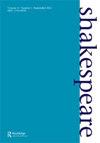The Duke of Gloucester’s Sword: Prosthetic Props in the Repertory of Edmund Kean
IF 0.2
3区 文学
0 LITERATURE, BRITISH ISLES
引用次数: 0
Abstract
ABSTRACT Edmund Kean played the role of Richard III for almost twenty years, in which time the most enduring images of his performance included his sword. Theatrical legend has it that this sword was passed down through generations of Shakespearean actors and found its resting place in Laurence Olivier’s tomb. The significance of the sword as a theatrical relic can be located in the archival traces of Kean’s performance style, particularly in James H. Hackett’s 1826 annotated copy of Richard III. The sword’s role in the performance takes on even more significance as Kean aged and became more physically debilitated. A performer known for his dynamic physicality, Kean was also recorded as struggling with physical impairments as a child. Moving from a mythical ‘overcoming’ of bodily challenges to simulating disability onstage as Richard to actual physical debility later in life, Kean continued to use his sword to ‘prop’ him up, literally and figuratively, on the stage. The sword becomes a prosthetic object, an addition to the body that shapes its movement and becomes an extension of the body itself. I argue that Kean’s sword throughout his career showed off his prodigious physical skill and then became enmeshed in his bodily decline.格洛斯特公爵的剑:埃德蒙·基恩剧目中的假体道具
摘要埃德蒙·基恩扮演理查三世近二十年,在这段时间里,他最经久不衰的表演形象包括他的剑。戏剧传说,这把剑代代相传,并在劳伦斯·奥利维尔的墓中找到了安息之地。这把剑作为戏剧遗迹的意义可以从基恩表演风格的档案痕迹中找到,特别是在詹姆斯·H·哈克特1826年的《理查三世》注释本中。随着基恩年龄的增长和身体的衰弱,这把剑在表演中的作用变得更加重要。基恩以其充满活力的身体素质而闻名,据记录,他小时候也曾与身体损伤作斗争。从神话般的“克服”身体挑战,到在舞台上扮演理查德,再到后来的实际身体虚弱,基恩继续在舞台上用剑“支撑”他,无论是字面上还是形象上。剑变成了一个假肢,是身体的一个补充,塑造了它的运动,并成为身体本身的延伸。我认为基恩在整个职业生涯中的剑展示了他惊人的身体技能,然后陷入了他的身体衰退。
本文章由计算机程序翻译,如有差异,请以英文原文为准。
求助全文
约1分钟内获得全文
求助全文
来源期刊

Shakespeare
Multiple-
CiteScore
0.30
自引率
33.30%
发文量
37
期刊介绍:
Shakespeare is a major peer-reviewed journal, publishing articles drawn from the best of current international scholarship on the most recent developments in Shakespearean criticism. Its principal aim is to bridge the gap between the disciplines of Shakespeare in Performance Studies and Shakespeare in English Literature and Language. The journal builds on the existing aim of the British Shakespeare Association, to exploit the synergies between academics and performers of Shakespeare.
 求助内容:
求助内容: 应助结果提醒方式:
应助结果提醒方式:


